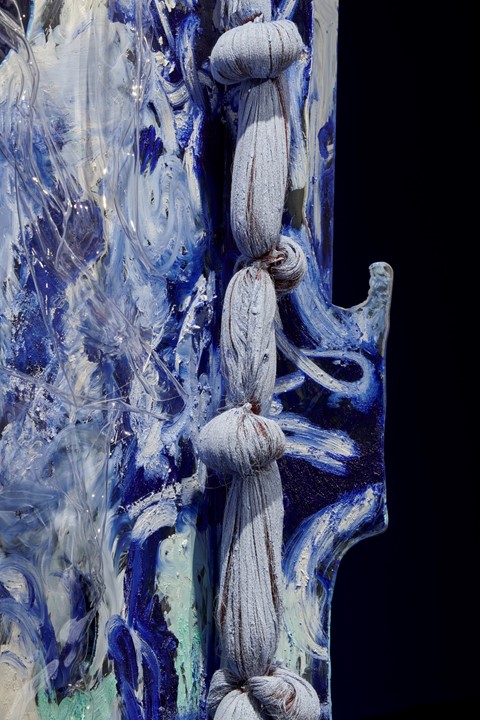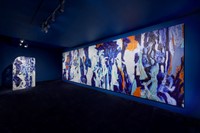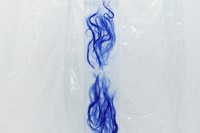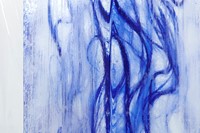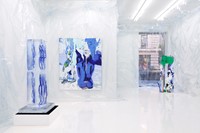Bolivian-American interdisciplinary artist Donna Huanca discusses her new exhibition WET SLIT, which transports visitors to a unique “death cocoon space”
“Intuition is the only way I can be authentic to my present moment,” Bolivian-American interdisciplinary artist Donna Huanca tells AnOther. Huanca’s sensitivity to her intuition, her most primal instincts, guides her exploration of the human body and its relationship to space and identity in works that combine painting, sculpture, performance, choreography, video, sound, and scent.
Inspired by Bolivia’s Festival de Urkupiña, a surreal fusion of traditional Catholic and Andean cultures full of sound, dance, costumes and food, Huanca’s new exhibition, WET SLIT, transforms the Simon Lee Gallery in London into two spaces that explore the polarities of light and dark, brightness and dimness, presence and absence. “The entrance floor represents the Earth’s surface and you enter the basement to descend into the underworld, the ‘death cocoon’ space,” she explains.
Huanca’s practice draws attention to skin as the interface by which we experience the world; her “skin” paintings referring directly to the body. Working exclusively with femme models and figures, Huanca is attempting to imagine a feminised future and the values of that reality, creating new modes of existing in space, where the flat and three-dimensional mingle and merge. The live performer’s body is present yet absent in the installation, found in the body rubbings, sealed and protected under transparent plastic, and in the traces still visible in the paintings. Here, Huanca shares her insights into creating an experience that simultaneously evokes the ephemeral and permanence of the world in which we live.
Miss Rosen: What was the inspiration for WET SLIT?
Donna Huanca: For this exhibition, I wanted to respond to the specific time and sterile climate we are living in. We are currently afraid to exchange fluids – and touching can feel risky.
I wanted to engage with the gallery space and contrast it by including non-collectable [or] ephemeral works such as a body rubbing and the ‘melting performer’ – where I trapped my performer’s hair into a monolith of ice that melted away on view over the course of the inaugural weekend. Each strand of our hair carries memory, chemical traces of our diet and the environment around us. Hair in this show is that container for history.
In all my installations, I always take into consideration the context of the space, its history and architecture in order to transform it. I wanted to acknowledge ‘nature’ in a new form, both toxic, artificial, yet protective. The layered scent of plastic and holy wood, mingled with the sanitary, antiseptic hand-sanitiser gel we are bathing in. Although the viewers are not allowed to touch the textures – they can be felt visually.
MR: How do you explore the paradox of the ephemeral and the permanent when conceptualising an immersive environment through painting, sculpture, sound, and scent?
DH: One of the main modalities of my practice is this action of layering, and the inverse – excavation. I am always building upon elements of works that have already happened; paintings that I made on the models, the sculptures and paintings that have been in installations, these are incorporated in all the new works. So in these new works you can also always excavate past temporalities.

MR: How does the idea of skin as the interface between ourselves and our experience of the world, and the way that it becomes an ideal canvas, transform the way we think about the femme body?
DH: I am interested in the way we self-decorate and adorn as a mode for communicating and signalling to others in order to create community. At the same time, there are all these ways that we are socially constructed, that we are assigned various social identities. I feel that the layering of paint on the skin, and the meditation in the performances can facilitate a letting go of the ego – letting go of the way our bodies and appearances are constructed and seen within the limited gaze of patriarchal society. Of course, the experience for each model is different, the layers of paint applied to their skin can be a method of erasure, of the ego, of that constructed self that is imposed, or it can also be a form of armour, protecting from, and distorting the gaze.
MR: Can you explain the resonance created by simultaneously exposing and concealing nudity beneath layers of paint, cosmetics?
DH: I am always a bit wary of people talking about the nudity in my work, somehow usually they are talking about nakedness as some kind of social object ... nakedness has all these complicated cultural meanings. In my personal life I try to think about the issues facing us in the present, in the everyday; in my work I want to project us into a new space, into a future space which values care, trust, community, the natural world and our bodies in proximity to and as part of it. It is not so much about the nakedness as it is about embodiment.
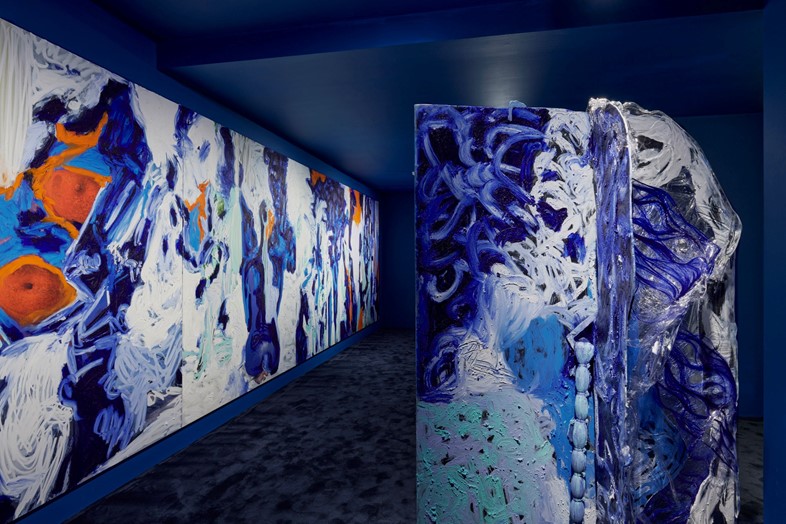
MR: How does the psychological space that the models occupy as live performers in the work and their presence create a powerful opportunity for viewers to examine their instinctive response to the femme body?
DH: Because there is no choreography, the performers choose when and how to make time work for them. I am interested in slowing down, and elongating time. I try to set up conditions where they feel safe to have an authentic experience over the duration of the work, which can take hours. I also ask the performers to write about their experience and will occasionally publish these texts with their permission.
MR: How do you transform the physical space – such as the cocooned space and the dark hermetic environment – as a means to physiologically communicate with viewers on pre-verbal, primordial terms?
DH: This non-verbal, primordial state that the dark environment creates, is the site of the joining of the cycle of birth and death. We are all sensitive to light, and our eyes trigger our memories. We were created in the darkness of a womb after all, and this was what I wanted to remind us of. We started in darkness and will end in darkness.
Donna Huanca: WET SLIT is at Simon Lee Gallery, London until April 18, 2020.
